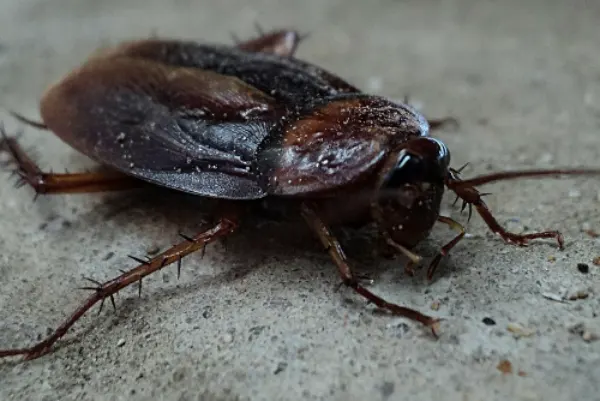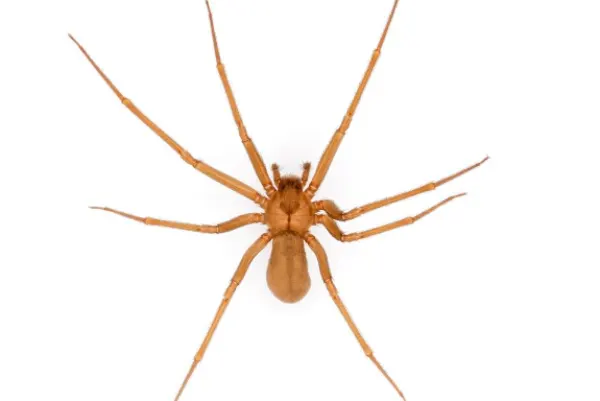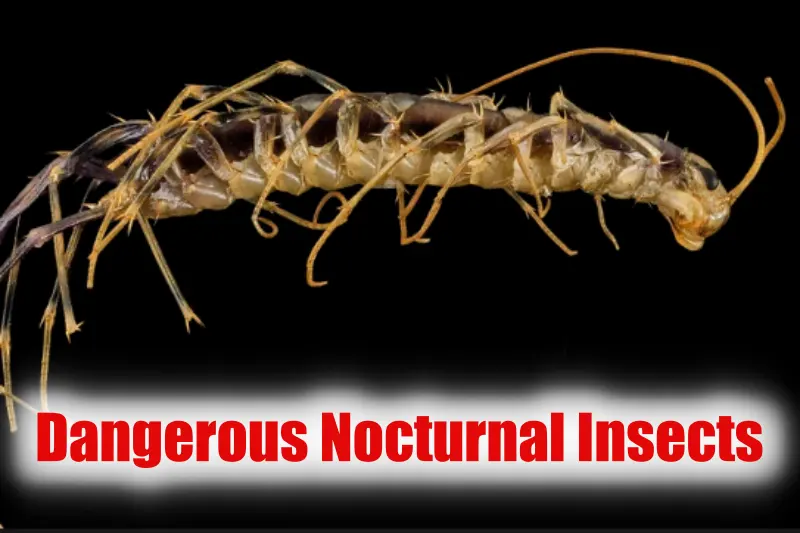Welcome back to another enlightening article as we delve into the nooks and corners of nature. Today, we present a comprehensive list of Dangerous Nocturnal Insects: Bugs That Are Most Active at Night and Pose Major Problems.
These 10 nocturnal insects, though small (except the Amazonian Giant centipede), are capable of causing bodily harm to humans and animals alike.
This guide will serve as a cautionary reference for newcomers to stay vigilant in their surroundings while making the most of the starry night.
Dangerous Nocturnal Insects: Bugs Are Most Active at Night & Cause Major Problems
10 Dangerous Nocturnal Insects
1) Cockroach

| Order | Blattodea |
| Size | From 3.5 mm to reaching up to 8 centimeters |
| Identification | They have a small head, a broad flattened body, and a tough exoskeleton coated with wax to repel water. |
| Danger Level | Medium
Cockroaches can carry pathogenic microbes on their body surfaces, potentially posing a risk to human health. |
Most species of cockroaches are about the size of a thumbnail, but their size can vary significantly.
The world’s heaviest cockroach is the Australian giant burrowing cockroach, Macropanesthia rhinoceros, reaching up to 8 centimeters (3 inches) in length and weighing up to 35 grams (1.2 ounces).
They typically have large compound eyes, two ocelli, and long, flexible antennae.
The body is divided into a thorax of three segments and a ten-segmented abdomen.
Wings, when present, are attached to the second and third thoracic segments.
They are also linked to allergic reactions in humans, and certain proteins in cockroach bodies can trigger allergies and asthma in susceptible individuals.
2) Mosquito

| Family | Culicidae |
| Size | They are typically 3–6 mm in length, but sizes can vary among species. |
| Identification | It has a slender, segmented body, one pair of wings covered in scales, and elongated mouthparts (proboscis). |
| Danger Level | Highly dangerous
Mosquitoes are significant vectors of diseases such as malaria, dengue fever, yellow fever, chikungunya, Zika, and West Nile virus. |
Mosquitoes undergo a four-stage life cycle: egg, larva, pupa, and adult. The larvae are aquatic and feed on algae and organic material.
Mosquitoes are notorious vectors of diseases. Their bites can transmit viruses and parasites, causing illnesses such as malaria, dengue fever, yellow fever, chikungunya, Zika, and West Nile virus.
An interesting approach to controlling the mosquito population is focusing on “elderly” female mosquitoes to prevent the evolution of resistance.
3) Vampire bugs
| Subfamily | Triatominae |
| Size | Around 1/2 to 3/4 inch long |
| Identification | They are known for their hematophagous behavior. |
| Danger Level | High
Triatomines are potential vectors of Chagas disease, caused by the parasite Trypanosoma cruzi. |
Also known as conenose bugs or kissing bugs, Triatominae has a distinctive life cycle with incomplete metamorphosis, progressing from egg to nymph to adult.
Their bites, in addition to transmitting the disease, can induce anaphylaxis in sensitive individuals.
They are nocturnal blood feeders and aggregate in refuges during the day and seek blood from hosts at night.
Insecticide treatment, particularly with synthetic pyrethroids, is a common method to control Triatominae infestations.
4) Asian giant hornet

| Scientific Name | Vespa mandarinia |
| Size | Body length of 45 mm, wingspan around 75 mm, stinger length of 6 mm |
| Identification | Large hornets with distinctive orange heads, brown antennae, dark eyes, and alternating bands of dark and yellow-orange on the abdomen. |
| Danger Level | High
Potent venom, painful stings, and potential for severe reactions, especially if stung by multiple hornets simultaneously. |
They are easily distinguishable by their large size and distinct features.
It has a light orange head, brown antennae with a yellow-orange base, dark brown to black eyes and ocelli, and large mandibles containing a black tooth.
The hornets prefer low mountains and forests, avoiding plains and high-altitude climates. They also exhibit a preference for subterranean nests, often occupying spaces around rotten pine roots.
They are intensely predatory, feeding on medium to large-sized insects, including bees, other hornet and wasp species, beetles, hornworms, mantises, and more.
5) Black Widow Spiders

| Genus | Latrodectus |
| Size | Females generally measure 25–38 mm |
| Identification | It is a dark-colored insect with a red or orange hourglass on the ventral abdomen; a distinctive hourglass marking. |
| Danger Level | Medium
Bites, particularly from females, can be harmful, causing latrodectism, but fatalities are rare, and most bites do not require medical treatment. |
The genus Latrodectus encompasses various species commonly known as true widows, including the notorious black widow spiders.
Females are typically dark-colored, exhibiting a red or orange hourglass on the ventral abdomen, while males display red or red-and-white markings on the dorsal abdomen.
Black widow spiders possess potent venom-containing latrotoxin, causing a condition known as latrodectism.
While their bites can be harmful to large vertebrates, including humans, fatalities are rare.
These spiders exhibit sexual cannibalism, with females occasionally consuming males after mating.
6) Brown Recluse Spider

| Scientific Name | Loxosceles reclusa |
| Size | It is typically between 6 and 20 millimeters |
| Identification | It has a distinctive violin pattern on the dorsal side of the cephalothorax |
| Danger Level | High
Bites can lead to loxoscelism, causing tissue destruction, skin necrosis, and in rare cases, systemic symptoms. |
The brown recluse spider, a member of the Sicariidae family, possesses necrotic venom, similar to other recluse spiders.
This venom, containing the dermonecrotic agent sphingomyelinase D, can lead to tissue destruction and occasionally result in a condition known as loxoscelism.
They exhibit a range of colors from light to medium brown, with markings on the dorsal side of the cephalothorax forming a distinctive violin pattern, earning them nicknames like fiddleback or violin spider.
Adult brown recluse spiders live about one to two years, with females producing multiple egg sacs, each containing around fifty eggs.
7) Fire ants

| Genus | Solenopsis |
| Size | The worker ants range from 2 to 6 mm |
| Identification | The pedicel has two nodes, an unarmed propodeum, and antennae with 10 segments |
| Danger Level | Medium
Potentially dangerous, especially for sensitive individuals, with painful stings and risks of anaphylaxis. |
Mature fire ants exhibit a distinct division into three body sections: head, thorax, and abdomen.
Red imported fire ant (RIFA), invasive in the United States, is recognized by its copper brown head and thorax, contrasting with a darker abdomen.
Their stinging mechanism involves a dedicated venom-injecting sting and powerful mandibles for biting.
They feed on young plants, insects, and seeds, displaying aggressive behavior, especially towards smaller animals.
8) Tsetse fly
| Genus | Glossina |
| Size | 0.5 to 1.5 centimeters in length |
| Identification | It has a long proboscis, folded wings, hatchet-shaped central wing cell, branched hairs on the antennal arista |
| Danger Level | High
It acts as a vector for trypanosomes, causing significant diseases in humans and animals. |
They inhabit various regions around tropical Africa, posing a significant threat due to their role as vectors for trypanosomes, causing human and animal trypanosomiasis.
Tsetse flies are obligate parasites, relying on blood meals from vertebrate animals for sustenance.
Females fertilize one egg at a time, retaining each egg in the uterus during the adenotrophic viviparity stage.
Offspring are nourished internally, and once reaching the third larval stage, they leave the uterus to undergo pupation in the ground.
9) Bed bug

| Genus | Cimex |
| Size | About 4 to 5 mm in length |
| Identification | It is flat, oval-shaped, light brown to reddish-brown, lacks hind wings, and emits a disagreeable odor when crushed. |
| Danger Level | Medium
Their bites can lead to various health impacts |
Bed bugs belong to the genus Cimex, with two primary species causing infestations: Cimex lectularius (common bed bug) and Cimex hemipterus (tropical bed bug).
The adult bed bugs lack hind wings, and their front wings are vestigial, appearing as pad-like structures.
They are nocturnal, feeding on warm-blooded hosts, preferably exposed skin like the face, neck, and arms.
Bed bugs are attracted to hosts by carbon dioxide, warmth, and specific chemicals, and they aggregate under various life stages and mating conditions.
10) Peruvian giant yellow-leg centipede
| Scientific Name | Scolopendra gigantea |
| Size | They can grow up to 30 centimeters |
| Identification | It is the largest centipede species, with distinctive yellow legs, and robust elongated body. |
| Danger Level | High
The venom is dangerous to humans |
Also known as the Amazonian giant centipede, it holds the title of the world’s largest centipede species, with a length exceeding 30 centimeters (12 inches).
It has a robust, elongated body with numerous segments, and its coloration is a mix of dark and lighter shades.
It prefers dark, moist places such as leaf litter or under rocks.
Its diet includes large insects, worms, snails, spiders, millipedes, scorpions, tarantulas, small lizards, frogs, snakes, sparrow-sized birds, mice, and even bats.
FAQs:
1) What is the #1 deadliest insect?
Ans. The deadliest insect, in terms of transmitting diseases to humans, is often considered to be the mosquito. Mosquitoes can carry and transmit diseases such as malaria, dengue fever, Zika virus, and more.
2) Which insect is nocturnal?
Ans. Many insects are nocturnal, meaning they are active during the night. Some examples of nocturnal insects include moths, fireflies, katydids, and certain species of beetles.
3) What insect is most active at night?
Ans. The insect that is most active at night is the mosquito. Mosquitoes are primarily active during the evening and night hours, seeking out hosts for blood meals.
4) What insect is feared the most?
Ans. Spiders are commonly feared by many people. Arachnophobia, the fear of spiders, is one of the most prevalent specific phobias.
5) What do kissing bugs do?
Ans. Kissing bugs are blood-feeding insects known for their bites, which they often deliver around the mouth or eyes of humans. They are called “kissing bugs” because they often bite humans on the face, particularly around the lips or eyes, while they sleep.
6) What insects have killed humans?
Ans. Mosquitoes are known to be one of the deadliest insects not because of their size or poison but rather their ability to serve as a vector to several viruses. They are responsible for over 700,000 human deaths annually, making them one of the deadliest animal taxa.
7) Are cockroaches nocturnal?
Ans. Yes, cockroaches are primarily nocturnal. They are more active during the night and tend to hide in dark places during the day.
8) Are ants nocturnal?
Ans. While some ants are primarily diurnal (active during the day), others, like the infamous army ants, can be nocturnal.
9) Is a mosquito a nocturnal insect?
Ans. Yes, a mosquito is a nocturnal insect. While some mosquitoes are mainly active during the day, others are more active during the night.
Conclusion
This concludes another article, delving into the world of creatures that lurk in the shadows, some not so little after all. These insects prefer their nighttime routine and cherish a good day’s sleep. This article not only sheds light on these nocturnal beings but is also crafted to help readers remain cautious during the night.
Also Read:

Hi everyone, my name is Shawna, and I’ve always been fascinated by the fascinating diversity of flora and fauna that our nature has in it. I am currently studying biotechnology and am particularly interested in animal biotechnology, delving into the intricate processes that define their true nature and uniqueness.
